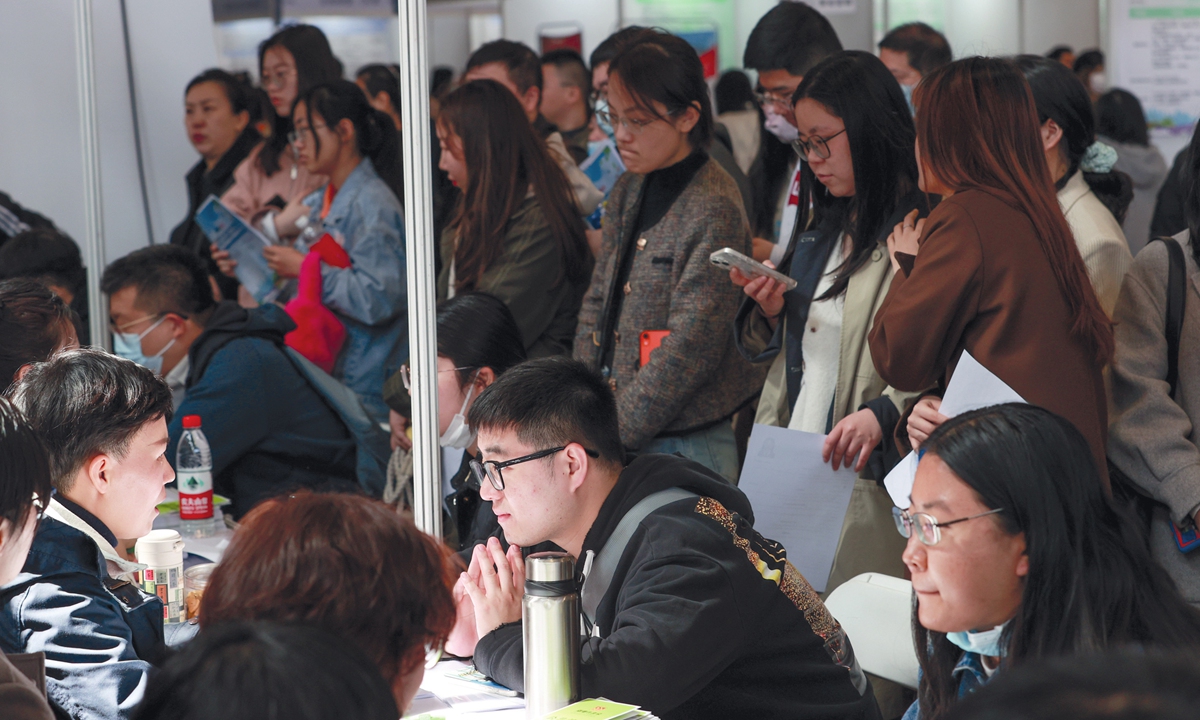China's labor market remains stable in Q1, with surveyed urban unemployment rate at 5.2% in March

People hunt for jobs at the 2024 Beijing large-scale spring on-site job fair on March 30, 2024. The recruitment event brought together 200 enterprises and institutions providing nearly 7,000 job opportunities. Photo: IC
China's surveyed urban unemployment rate in the first quarter of 2024 came in at 5.2 percent, down 0.3 percentage points year-on-year, indicating an overall stable employment situation, the National Bureau of Statistics (NBS) said on Tuesday.
The surveyed urban unemployment rate also stood at 5.2 percent in March, a year-on-year decrease of 0.1 percentage point, per NBS data.
Experts said that China's economic revival, rapid rise of new quality productive forces and non-stop policy support are the major advantages in stabilizing the labor market and will further boost employment.
Policies to stabilize employment have already shown an obvious effect, and the structural problem will turn out to be more serious without supported policies, Sheng Laiyun, deputy director of the NBS, said on Tuesday, the paper.cn reported.
Sheng said that he remained optimistic about China's job market. He noted that on the one hand, the continuously expanding economy will need labor, adding that more than 10 million jobs were created in 2023 amid a GDP increase of 6 trillion yuan ($828.86 billion). On the other hand, the rapidly developing services industry amid China's industrial upgrading will absorb more workers, as the services sector accounts for 55 percent of China's GDP and provides employment flexibility.
In addition to dedicated government support, the economic rebound - especially in the manufacturing and services sectors - drove up labor demand in the first quarter, while the development of new quality productive forces created a new growth point with more job opportunities, Wang Peng, an associate research fellow at the Beijing Academy of Social Sciences, said in an interview with the Global Times on Tuesday.
As to the recovery of the services sector, robust tourism has played a vital role in offering new jobs, Zhang Yi, CEO of iiMedia Research Institute, told the Global Times on Tuesday.
Data from recruiting platform Liepin.com showed that new jobs posted by the travel industry increased by 25.72 percent year-on-year in the first quarter. There were remarkable rises in jobs related to artificial intelligence in the first quarter, and salaries were also higher.
The number of jobs for natural language processing engineers rose by 126 percent year-on-year on recruiting platform Zhaopin.com, while their salaries increased by 12 percent to 24,535 yuan per month, according to data Zhaopin.com sent to the Global Times.
Despite the favorable conditions, challenges remain. Sheng said that special attention is needed regarding structural contradictions, with an oversupply of blue-collar workers along with strong pressure on college graduates,according to the paper.cn.
Sheng noted that the youth unemployment rate slightly increased in the first quarter, which still needs high attention, stressing that the responsible authorities have been actively creating favorable conditions targeting the employment of college students.
Wang said that the job market is also facing challenges including relatively fierce competition in sectors such as finance and information technology, and some job seekers' skills don't match corresponding positions, so it's important to enhance skills training and guidance.
China has been ramping up efforts to boost the job market. The Ministry of Human Resources and Social Security recently announced that it held about 64,000 recruitment events during a three-month spring recruitment campaign across the country, offering more than 43 million jobs, marking a 10 percent increase both in terms of events held and jobs created year-on-year.
